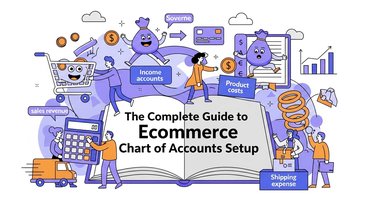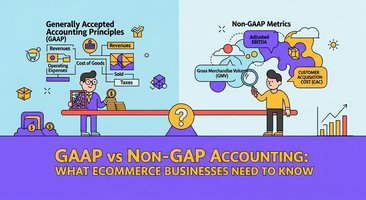Managing finances across multiple sales channels can feel overwhelming. Between Amazon FBA fees, Shopify transaction costs, eBay listing fees, and Etsy payment processing, keeping track of your true profitability becomes a complex puzzle. However, with the right systems and tools, you can master multi-channel bookkeeping and gain crystal-clear visibility into your business performance.In this comprehensive guide, we'll show you exactly how to organize your books across platforms, automate your financial processes, and make data-driven decisions that drive growth.
Why Multi-Channel Selling Complicates Your Bookkeeping
Multi-channel selling offers tremendous opportunities for growth, but it also introduces unique accounting challenges that single-platform sellers never face.
The Multi-Channel Accounting Challenge
When you sell on multiple platforms, each channel operates with different:
- Fee structures (Amazon charges referral fees, Shopify charges transaction fees, eBay has insertion fees)
- Payout schedules (Amazon pays bi-weekly, Shopify daily, eBay varies by region)
- Tax collection policies (Some platforms collect sales tax, others don't)
- Currency handling (International sales add exchange rate complications)
- Refund processes (Each platform handles returns differently)
Without proper organization, these differences create a bookkeeping nightmare that can hide your true profitability and lead to costly mistakes.
Common Multi-Channel Bookkeeping Mistakes
- Treating All Revenue the SameMany sellers lump all sales together, ignoring the fact that Amazon sales have different fee structures than Shopify sales. This leads to inaccurate profit calculations.2. Ignoring Platform-Specific FeesEach platform has unique fee structures. Amazon charges referral fees and FBA fees, while Shopify charges transaction fees and payment processing fees. Failing to account for these differences skews your profitability analysis.3. Manual Data Entry ErrorsManually entering data from multiple platforms is time-consuming and error-prone. A single mistake can throw off your entire financial picture.4. Inconsistent Chart of AccountsUsing different account categories for similar expenses across platforms makes it impossible to get a clear view of your overall business performance.
The Foundation: Setting Up Your Multi-Channel Chart of Accounts
Before diving into platform-specific strategies, you need a solid foundation: a properly structured chart of accounts that works across all your sales channels.
Revenue Categories
Create separate revenue accounts for each platform:
- Amazon Sales Revenue
- Shopify Sales Revenue
- eBay Sales Revenue
- Etsy Sales Revenue
- Direct Website Sales
This separation allows you to track which platforms are driving the most revenue and analyze performance trends.
Expense Categories
Organize expenses by type, not by platform:
- Cost of Goods Sold (COGS)
- Amazon Fees (referral fees, FBA fees, advertising)
- Shopify Fees (transaction fees, app subscriptions)
- eBay Fees (insertion fees, final value fees)
- Etsy Fees (transaction fees, listing fees)
- Payment Processing Fees
- Shipping Costs
- Inventory Storage
- Marketing & Advertising
Asset and Liability Accounts
Track platform-specific assets and liabilities:
- Amazon Seller Account Balance
- Shopify Payments Pending
- eBay Managed Payments
- Etsy Payments Account
- Inventory by Location (Amazon FBA, your warehouse, etc.)
Platform-Specific Bookkeeping Strategies
Each sales platform has unique characteristics that require specific approaches to maintain accurate books.
Amazon Bookkeeping
Amazon's complex fee structure and FBA program create unique accounting challenges.Key Amazon Fees to Track:
- Referral fees (typically 8-15% of sale price)
- FBA fulfillment fees (varies by size and weight)
- Monthly storage fees
- Long-term storage fees
- Advertising costs (PPC campaigns)
- Return processing fees
Amazon Payout Structure:Amazon pays sellers every two weeks, but the payout amount rarely matches your gross sales due to various fees and adjustments. Each settlement report includes:
- Sales revenue
- Refunds and chargebacks
- FBA fees
- Advertising costs
- Other adjustments
Best Practice: Use Amazon's settlement reports as your primary source of truth. Don't rely solely on your seller dashboard, as it may not reflect all fees and adjustments.
Shopify Bookkeeping
Shopify offers more control over your financials, but this flexibility requires careful management.Key Shopify Fees to Track:
- Monthly subscription fees
- Transaction fees (varies by plan)
- Payment processing fees (Shopify Payments)
- App subscription costs
- Theme and development costs
Shopify Payout Structure:Shopify typically pays out daily (depending on your settings), making cash flow more predictable. However, you still need to account for:
- Chargebacks and disputes
- Refunds and returns
- Payment processing fees
- Currency conversion fees (for international sales)
Best Practice: Use Shopify's built-in analytics alongside your accounting software to maintain accurate records. The platform provides detailed transaction data that makes reconciliation easier.
eBay Bookkeeping
eBay's fee structure has evolved significantly with the introduction of Managed Payments.Key eBay Fees to Track:
- Final value fees (typically 10-12% of total sale)
- Insertion fees (for auction-style listings)
- Promoted listings fees
- Store subscription fees
- PayPal fees (if still using PayPal)
eBay Payout Structure:With Managed Payments, eBay handles payment processing and pays sellers on a regular schedule. This simplifies bookkeeping but requires tracking:
- Sales revenue
- eBay fees
- Payment processing fees
- Refunds and returns
Best Practice: Download eBay's monthly statements and reconcile them with your accounting software. The platform provides detailed fee breakdowns that make tracking easier.
Etsy Bookkeeping
Etsy's marketplace focuses on handmade and vintage items, with a unique fee structure.Key Etsy Fees to Track:
- Transaction fees (6.5% of sale price plus shipping)
- Payment processing fees (3% + $0.25 per transaction)
- Listing fees ($0.20 per item)
- Advertising fees (Etsy Ads)
- Currency conversion fees
Etsy Payout Structure:Etsy typically deposits funds within 1-3 business days, making cash flow management easier. However, you need to account for:
- Sales revenue
- Etsy fees
- Payment processing fees
- Refunds and returns
Best Practice: Use Etsy's CSV download feature to export transaction data directly into your accounting software.
Automation: The Key to Multi-Channel Success
Manual bookkeeping across multiple platforms is not scalable. As your business grows, automation becomes essential for maintaining accuracy and saving time.
Why Automation Matters
Time Savings: Automation eliminates hours of manual data entry each week.Accuracy: Automated systems reduce human error and ensure consistent categorization.Real-time Insights: Get up-to-date financial data without waiting for manual updates.Scalability: Add new sales channels without proportionally increasing your workload.
Klavena: Your Multi-Channel Automation Solution
This is where Klavena's ecommerce accounting automation platform becomes invaluable. Klavena is specifically designed to handle the complexities of multi-channel selling, offering:Seamless Integration: Klavena automatically connects with Amazon, Shopify, eBay, Etsy, and other major platforms, pulling transaction data in real-time.Intelligent Categorization: The platform automatically categorizes transactions, fees, and refunds according to your chart of accounts, ensuring consistency across all channels.Unified Dashboard: View performance metrics from all your sales channels in one place, making it easy to identify trends and opportunities.QuickBooks Integration: Klavena seamlessly syncs with QuickBooks, ensuring your accounting software always has the most current data.Fee Reconciliation: Automatically track and categorize platform-specific fees, giving you accurate profit margins for each channel.Multi-Currency Support: Handle international sales with automatic currency conversion and proper accounting treatment.
Advanced Multi-Channel Bookkeeping Strategies
Once you have the basics in place, these advanced strategies will help you optimize your multi-channel operations.
Profit Analysis by Channel
Track key metrics for each platform:
- Gross Revenue: Total sales before any deductions
- Net Revenue: Revenue after platform fees and refunds
- Cost of Goods Sold: Direct costs associated with products sold
- Gross Profit: Net revenue minus COGS
- Operating Expenses: Platform-specific costs like advertising and storage
- Net Profit: Final profit after all expenses
Inventory Management Across Platforms
Maintaining accurate inventory records across multiple channels is crucial for profitability analysis.Key Strategies:
- Use SKU-based tracking to monitor inventory across all platforms
- Implement first-in, first-out (FIFO) inventory valuation
- Track inventory by location (Amazon FBA, your warehouse, etc.)
- Monitor inventory turnover rates by platform
- Account for platform-specific storage costs
Cash Flow Management
Different payout schedules across platforms can create cash flow challenges.Best Practices:
- Create a cash flow forecast that accounts for each platform's payout schedule
- Maintain separate bank accounts for each major platform if needed
- Monitor accounts receivable to ensure timely payments
- Plan for seasonal fluctuations in each channel
Tax Compliance Across Platforms
Multi-channel selling complicates tax compliance, especially for sales tax and international transactions.Key Considerations:
- Track sales tax collected by each platform
- Maintain records for international sales and VAT obligations
- Separate taxable and non-taxable sales by jurisdiction
- Keep detailed records for potential audits
Reporting and Analytics for Multi-Channel Success
Effective reporting transforms your bookkeeping data into actionable business insights.
Essential Reports for Multi-Channel Sellers
- Platform Performance ReportCompare revenue, expenses, and profitability across all channels to identify your most profitable platforms.2. Product Profitability AnalysisUnderstand which products perform best on each platform, accounting for platform-specific fees and costs.3. Cash Flow ForecastPredict future cash needs based on each platform's payout schedule and seasonal trends.4. Fee Analysis ReportTrack how platform fees impact your profitability and identify opportunities for optimization.5. Inventory Turnover ReportMonitor how quickly inventory moves on each platform to optimize stock levels and reduce carrying costs.
Using Klavena's Reporting Features
Klavena's built-in reporting capabilities make it easy to generate these critical reports:Real-time Dashboards: Monitor key metrics across all platforms without manual data compilation.Automated Report Generation: Schedule regular reports to be delivered to your inbox, ensuring you never miss important trends.Customizable Metrics: Track the KPIs that matter most to your business, with the ability to drill down into specific platforms or time periods.Profit Margin Analysis: Understand true profitability by product and platform, accounting for all fees and costs.
Common Pitfalls and How to Avoid Them
Learn from the mistakes of other multi-channel sellers to protect your business.
Pitfall 1: Inconsistent Data Entry
Problem: Manual data entry leads to inconsistencies and errors across platforms.Solution: Use automation tools like Klavena to ensure consistent, accurate data entry.
Pitfall 2: Ignoring Platform-Specific Fees
Problem: Failing to account for unique fee structures leads to inaccurate profitability analysis.Solution: Set up detailed expense categories for each platform's fee structure.
Pitfall 3: Poor Cash Flow Management
Problem: Different payout schedules create cash flow gaps.Solution: Create detailed cash flow forecasts and maintain adequate working capital.
Pitfall 4: Inadequate Inventory Tracking
Problem: Poor inventory management leads to stockouts and overstock situations.Solution: Implement SKU-based tracking and monitor inventory levels across all platforms.
Pitfall 5: Neglecting Tax Compliance
Problem: Complex multi-channel tax requirements lead to compliance issues.Solution: Work with a qualified accountant and use software that handles multi-jurisdiction tax compliance.
Scaling Your Multi-Channel Operations
As your business grows, your bookkeeping systems need to scale with you.
Preparing for Growth
Standardize Processes: Document your bookkeeping procedures to ensure consistency as you add team members.Invest in Technology: Tools like Klavena become even more valuable as transaction volumes increase.Plan for New Channels: Design your chart of accounts to easily accommodate new sales platforms.Monitor Key Metrics: Focus on metrics that matter most for scaling, such as customer acquisition cost and lifetime value by channel.
When to Hire Professional Help
Consider professional bookkeeping services when:
- Monthly transaction volume exceeds 1,000 transactions
- You're expanding internationally
- Tax compliance becomes complex
- You need more time to focus on business growth
Conclusion: Master Multi-Channel Bookkeeping with the Right Tools
Multi-channel selling offers tremendous opportunities for growth, but success requires proper financial management. By implementing the strategies outlined in this guide and leveraging automation tools like Klavena, you can:
- Maintain accurate books across all platforms
- Gain clear visibility into channel profitability
- Make data-driven decisions that drive growth
- Scale your operations efficiently
Remember, the key to multi-channel success isn't just selling on multiple platforms—it's understanding the true profitability of each channel and optimizing your operations accordingly.Ready to streamline your multi-channel bookkeeping? Klavena's ecommerce accounting automation platform makes it easy to manage finances across Amazon, Shopify, eBay, Etsy, and more. With automatic transaction categorization, real-time reporting, and seamless QuickBooks integration, you'll have the financial clarity needed to scale your multi-channel business successfully.Start your free trial today and experience the power of automated multi-channel bookkeeping.





